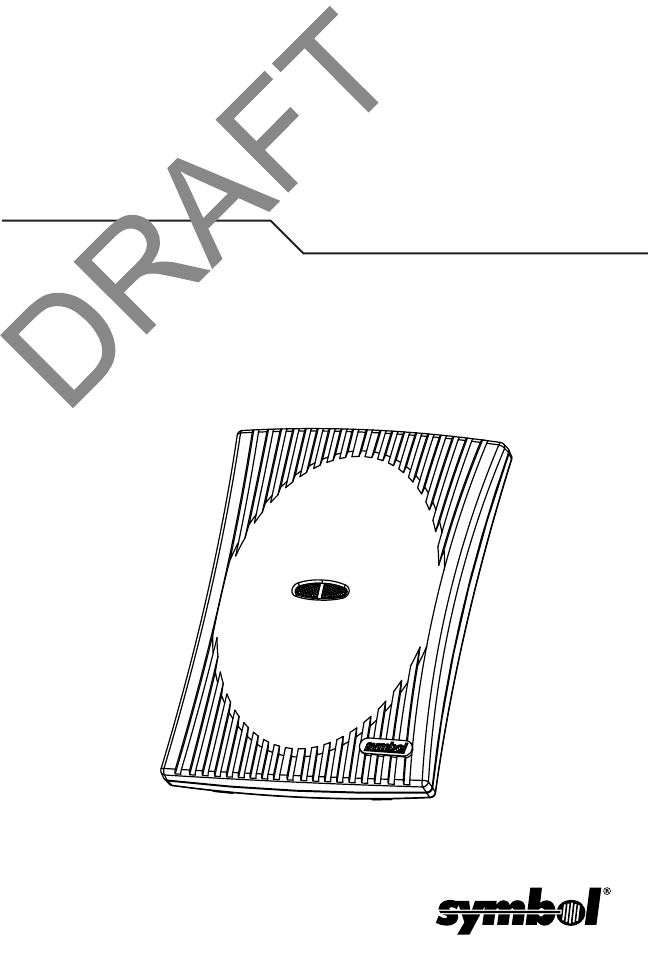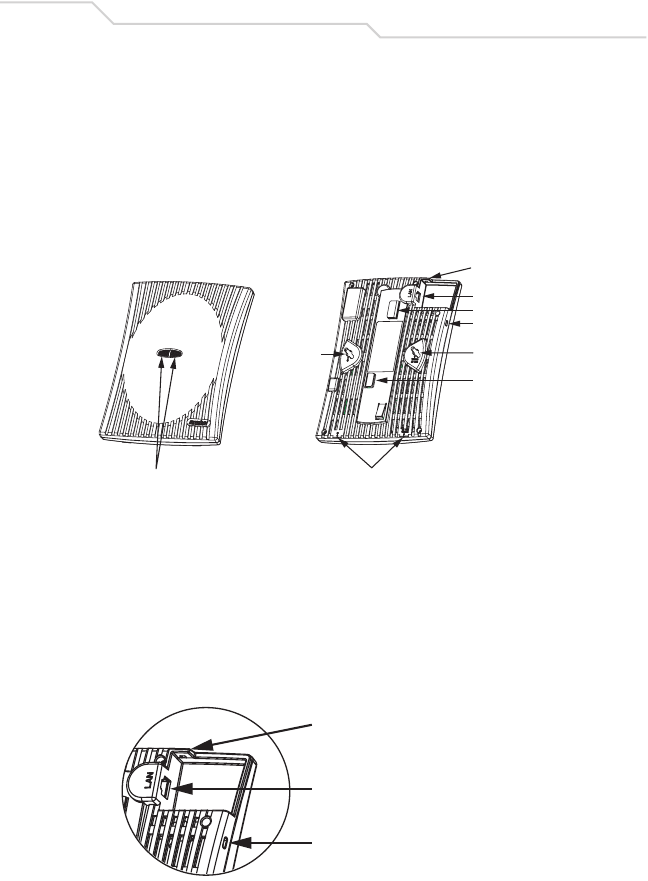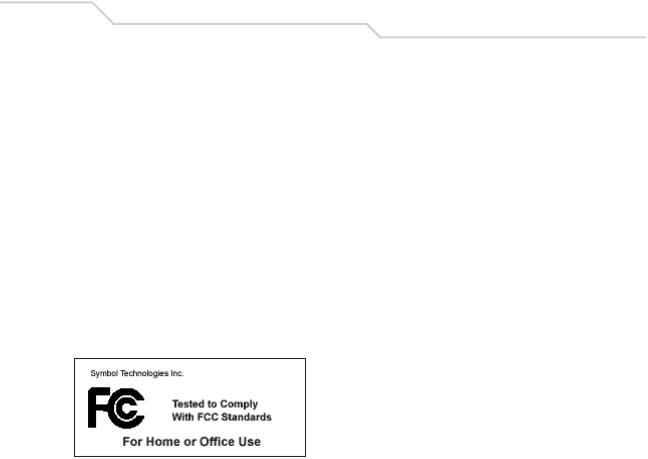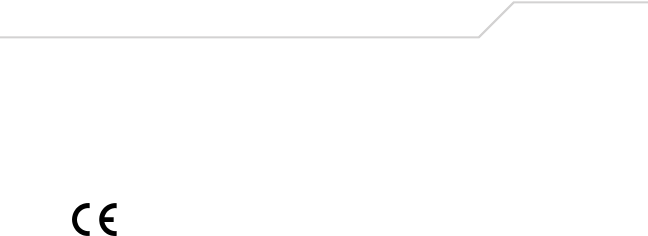Symbol Technologies WSAP5100BG 802.11 b/g WLAN ACCESS PORT User Manual AP300iQRG008
Symbol Technologies Inc 802.11 b/g WLAN ACCESS PORT AP300iQRG008
Contents
- 1. users manual 1
- 2. users manual 2
users manual 2

802.11a/b/g Access Port
Internal Antenna Model
Quick Reference Guide
AP 300

AP 300 Quick Reference Guide FINAL.Not for distribution.
Copyright
© 2004 SYMBOL TECHNOLOGIES, INC. All rights reserved.
All rights reserved. No part of this publication may be modified or adapted in any way, for any
purposes without permission in writing from Symbol Technologies, Inc. (Symbol). The material in
this manual is subject to change without notice. Symbol reserves the right to make changes to
any product to improve reliability, function, or design. No license is granted, either expressly or
by implication, estoppels, or otherwise under any Symbol Technologies, Inc., intellectual property
rights. An implied license only exists for equipment, circuits and subsystems contained in Symbol
products. Symbol, the Symbol logo and Spectrum24 are registered trademarks of Symbol
Technologies, Inc.
Patents
This product is covered by one or more of the following U.S. and foreign Patents:
U.S. Patent No. 4,593,186; 4,603,262; 4,607,156; 4,652,750; 4,673,805; 4,736,095;
4,758,717; 4,760,248; 4,806,742; 4,816,660; 4,845,350; 4,896,026; 4,897,532; 4,923,281;
4,933,538; 4,992,717; 5,015,833; 5,017,765; 5,021,641; 5,029,183; 5,047,617; 5,103,461;
5,113,445; 5,130,520; 5,140,144; 5,142,550; 5,149,950; 5,157,687; 5,168,148; 5,168,149;
5,180,904; 5,216,232; 5,229,591; 5,230,088; 5,235,167; 5,243,655; 5,247,162; 5,250,791;
5,250,792; 5,260,553; 5,262,627; 5,262,628; 5,266,787; 5,278,398; 5,280,162; 5,280,163;
5,280,164; 5,280,498; 5,304,786; 5,304,788; 5,306,900; 5,324,924; 5,337,361; 5,367,151;
5,373,148; 5,378,882; 5,396,053; 5,396,055; 5,399,846; 5,408,081; 5,410,139; 5,410,140;
5,412,198; 5,418,812; 5,420,411; 5,436,440; 5,444,231; 5,449,891; 5,449,893; 5,468,949;
5,471,042; 5,478,998; 5,479,000; 5,479,002; 5,479,441; 5,504,322; 5,519,577; 5,528,621;
5,532,469; 5,543,610; 5,545,889; 5,552,592; 5,557,093; 5,578,810; 5,581,070; 5,589,679;
5,589,680; 5,608,202; 5,612,531; 5,619,028; 5,627,359; 5,637,852; 5,664,229; 5,668,803;
5,675,139; 5,693,929; 5,698,835; 5,705,800; 5,714,746; 5,723,851; 5,734,152; 5,734,153;
5,742,043; 5,745,794; 5,754,587; 5,762,516; 5,763,863; 5,767,500; 5,789,728; 5,789,731;
5,808,287; 5,811,785; 5,811,787; 5,815,811; 5,821,519; 5,821,520; 5,823,812; 5,828,050;
5,848,064; 5,850,078; 5,861,615; 5,874,720; 5,875,415; 5,900,617; 5,902,989; 5,907,146;
5,912,450; 5,914,478; 5,917,173; 5,920,059; 5,923,025; 5,929,420; 5,945,658; 5,945,659;
5,946,194; 5,959,285; 6,002,918; 6,021,947; 6,029,894; 6,031,830; 6,036,098; 6,047,892;
6,050,491; 6,053,413; 6,056,200; 6,065,678; 6,067,297; 6,082,621; 6,084,528; 6,088,482;
6,092,725; 6,101,483; 6,102,293; 6,104,620; 6,114,712; 6,115,678; 6,119,944; 6,123,265;
6,131,814; 6,138,180; 6,142,379; 6,172,478; 6,176,428; 6,178,426; 6,186,400; 6,188,681;
6,209,788; 6,209,789; 6,216,951; 6,220,514; 6,243,447; 6,244,513; 6,247,647; 6,308,061;
6,250,551; 6,295,031; 6,308,061; 6,308,892; 6,321,990; 6,328,213; 6,330,244; 6,336,587;
6,340,114; 6,340,115; 6,340,119; 6,348,773; 6,380,949; 6,394,355; D305,885; D341,584;
D344,501; D359,483; D362,453; D363,700; D363,918; D370,478; D383,124; D391,250;
D405,077; D406,581; D414,171; D414,172; D418,500; D419,548; D423,468; D424,035;
D430,158; D430,159; D431,562; D436,104.
Invention No. 55,358; 62,539; 69,060; 69,187, NI-068564 (Taiwan); No. 1,601,796; 1,907,875;
1,955,269 (Japan); European Patent 367,299; 414,281; 367,300; 367,298; UK 2,072,832;
France 81/03938; Italy 1,138,713
rev. 06/02
Symbol Technologies, Inc.
One Symbol Plaza
Holtsville, N.Y. 11742-1300
http://www.symbol.com

1
FINAL.Not for distribution.
Introduction
The AP 300 Access Port, a component of the Symbol Wireless Switch
System, links wireless 802.11a/b/g devices to the switch, enabling
incremental growth of your wireless network with a cost-effective
alternative to standard access points. For optimal performance, the AP
300 provides two placement options: wall and ceiling. Wall mount slots
fit onto two screws provided; marks on the AP 300 case guide placement
of the screws. Clips on the back of the case fit onto a suspended ceiling
T-bar.
The AP 300 receives all power and transfers data through the same
CAT-5 cable without any strain relief. There is no additional power
supply.
Technical Specifications
Dimensions & Weight
Operating Voltage 48VDC typical; 36-57VDC
range
Power Over Ethernet
Operating Current 10mA to 165mA
Peak Current 250mA
Operating
Temperature
-20°C to 50°C (-4°F to 122°F)
Operating Humidity 5% to 95% non-condensing
Storage Temperature -40°C to 70°C (-40°F to
158°F)
Storage Humidity 85%
Altitude 2438m (8,000ft.) maximum operating
4572m (15,000ft.) maximum storage
Drop 91cm (36in.) to concrete Without antenna modules
Electrostatic
Discharge
+/-15kV air; +/-8kV contact;
+/-2kV pin
Length 21.1cm (8.31in)
Width 17.1cm (6.74in.)
Height 5.1cm (2.0in.)
Weight 0.45kg (1.0lbs)

2AP 300 Quick Reference Guide FINAL.Not for distribution.
Radio Characteristics
The AP 300 is an IEEE 802.11a/b/g-compliant device with the
appropriate radio option configured. The table below shows the
characteristics for each device compliance.
Package Contents
The AP 300 package contains the following items:
• AP 300 Access Port
• Two wide-shoulder screws
Device Mbps Data Rate
Support
Utilizing
Diversity
GHz
802.11a 6, 9, 12, 18, 24, 36, 48,
and 54
Transmit and
receive 4.9 to 5.875 range
802.11g* 1.0, 2.0, 5.5, 6, 9, 12, 18,
24, 36, 48, and 54
Transmit and
receive
2.4 to 2.5 ISM range
*The supported 802.11g modes include either CCK only or OFDM only.

3
FINAL.Not for distribution.
Description
The AP 300 has two radios capable of concurrent 802.11a/b/g radio
configurations. The AP 300 takes power from any 802.3af-compatible
Power Over Ethernet (PoE) switch or power injector.
Features
• One RJ-45 connector
• LED indicators
• Point for a safety cable loop
• Kensington© Lock Port
• Slots for wall mounting
• Clips for ceiling T-bar mounting
The AP 300 has one RJ-45 connector for a 10/100 Ethernet port
connecting to a wireless switch with a standard CAT-5 cable, straight
through or cross-over, without any strain relief.
Top View
LEDs
Mount Slot
Bottom View
Mount Slot
Lock Port
T-bar Mount
RJ-45
Safety Cable
Tie Point
Alignment Arrows
T-bar Mount
Safety Cable Tie Point
RJ-45 Connector
Lock Port

4AP 300 Quick Reference Guide FINAL.Not for distribution.
The AP 300 receives power through the Ethernet cable, optionally
connected to a Port Power Injector—for example, Symbol Model AP-
PSBIAS-T-12-AF Power Injector 12 Port. See the Symbol web site for
available PoE devices.
Review installation plans to determine device placement and cable
routing.
The AP 300 Access Port comprises two 802.11 radios: an 802.11b/g
radio operating in the 2.4 to 2.5GHz band and an 802.11a radio
operating in the 4.9 to 5.875GHz band. Each radio has an embedded
controller which runs local firmware used to perform the functions of the
lower 802.11 MAC. All upper MAC functions and MAC management are
controlled by the Wireless Switch.
Motherboard firmware enables the AP 300 to boot after either a power
up or a watchdog reset. After self-boot, the motherboard sends an “I am
alive” message into the network to be adopted and loaded with the actual
runtime code. The boot firmware on the motherboard and the firmware
downloaded from the switch can be modified via the Ethernet interface
from either the Wireless Switch or by other Symbol diagnostic software
tools.
LED Indicators
The LED activity indicators on the top of the case provide a status
display indicating error conditions, transmission, and network activity for
the 802.11a (amber) radio or the 802.11b/g (green) radio.
802.11a Activity LED Amber
802.11b/g Activity LED Green
Booting The amber LED flashes three times per second until firmware is
loaded. During boot, no 802.11a mobiles can associate.
Normal After adoption, the amber LED is steady or flashes with 802.11a radio
traffic.
Error The amber LED flashes once per second if an error prevents the
802.11a radio from operating normally.
Booting The green LED flashes three times per second until firmware is
loaded. During boot, no 802.11b/g mobiles can associate.
Normal After adoption, the green LED is steady or flashes with 802.11b/g
radio traffic.
Error The green LED flashes once per second if an error prevents the
802.11b/g radio from operating normally.

5
FINAL.Not for distribution.
Installation Instructions
The AP 300 mounts either on a wall with wide-shouldered screws
included or on a suspended ceiling T-bar.
Before Beginning
Perform the following:
• Match the model number on the purchase order with the model
numbers in the packing list and on the case of the device shipped.
• Verify that the contents of the box include the intended AP 300 and
the mounting hardware:
• Review site survey and network analysis reports to determine the
location and mounting position for the AP 300.
Wall Mounting
In the procedure below, hang the AP 300 Access Port along its length or
width using the slots on the bottom of the unit.
Hardware
• A CAT-5 cable connected to a compatible Symbol wireless
switch—for example, the WS 2000 or WS 5000—with sufficient
slack and without a molded or integrated strain relief on the
connector to the AP 300
• Two wide-shoulder Phillips pan head self-tapping screws
(provided)
• Case: In the procedure, use the arrows on the back of the AP
300’s case as a guide to determine the proper placement for the
unit’s mounting screws.
• Safety cable (recommended)
• Security cable (optional)
Procedure
1. Orient the case on the wall by its length or width.
Item Notes
WSAP-5030-300-WW 802.11a/b/g configuration.
Mounting Hardware: Two wide-shoulder Phillips
pan head self-tapping screws.

6AP 300 Quick Reference Guide FINAL.Not for distribution.
2. Using the arrows on the bottom edge of the back of the case as
guides, move the edge to the midline of the mounting area and
mark points on the midline for the screws.
3. At each point, screw in the self-tapping screws and stop where the
threads meet the shank or shoulder of the screw.
4. If required, install the recommended safety cable—steel with a
diameter at least .15cm (.06in.)—and a security cable, and attach
them to the unit.
5. Place the middle of each of the case’s mount slots over the screw
heads.
6. Slide the case down along the mounting surface to hang the
case’s slots on the screw heads.
7. Plug the Ethernet cable into the LAN port.
8. Verify the unit has power by observing that the LEDs are lit or
flashing.
Suspended Ceiling T-Bar Mount
In this procedure, hold and twist the AP 300 on a T-bar of a suspended
ceiling grid, clicking the case into place.
Hardware
• A CAT-5 cable connected to a compatible Symbol wireless
switch—for example, the WS 2000 or WS 5000—with sufficient
slack and without a molded or integrated strain relief on the
connector to the AP 300
• Safety cable (recommended)
• Security cable (optional)
Procedure
1. If required, install the recommended safety cable—steel with a
diameter at least .15cm (.06in.)—to the safety cable tie point and
a security cable to the unit’s lock port.
2. Plug the Ethernet cable into the LAN port.
3. Face the bottom of the T-bar with the back of the case.
4. Orient the case by its length and the length of the T-bar.
5. Rotate the case in place 45 degrees counter-clockwise, or about
10 o’clock.

7
FINAL.Not for distribution.
6. Push the back of the case onto the bottom of the T-bar.
7. Rotate the case 45 degrees clockwise. The clips click as they
fasten to the T-bar.
8. Verify the unit has power by observing the LEDs.

8AP 300 Quick Reference Guide FINAL.Not for distribution.
Customer Support
Symbol Technologies provides its customers with prompt and accurate
customer support. Use the Symbol Support Center as the primary
contact for any technical problem, question or support issue involving
Symbol products.
If the Symbol Customer Support specialists cannot solve a problem,
access to all technical disciplines within Symbol becomes available for
further assistance and support. Symbol Customer Support responds to
calls by e-mail, telephone or fax within the time limits set forth individual
contractual agreements.
When contacting Symbol Customer Support, please provide the
following information:
• Device serial number
• Product name or model number
• Software type and version number
North American Contacts
Inside North America, contact Symbol at:
Symbol Technologies, Inc.
One Symbol Plaza
Holtsville, New York 11742-1300
Telephone: 1-631-738-2400/1-800-SCAN 234
Fax: 1-631-738-5990
Symbol Support Center (for warranty and service information):
Telephone: 1-631-738-6213/1-800-653-5350
Fax: (631) 563-5410
E-mail: support@symbol.com
International Contacts
Outside North America, contact Symbol at:
Symbol Technologies, Inc.
Symbol Place
Winnersh Triangle, Berkshire, RG41 5TP
United Kingdom
0800-328-2424 (Inside UK)
+44 118 945 7529 (Outside UK)

9
FINAL.Not for distribution.
Web Support Sites
MySymbolCare
http://www.symbol.com/services/msc
Symbol Services Homepage
http://symbol.com/services
Symbol Software Updates
http://symbol.com/services/downloads
Symbol Developer Program
http://software.symbol.com/devzone
Symbol Knowledge Base
http://kb.symbol.com/register.asp
Additional Information
Obtain additional information by contacting Symbol at:
• 1-800-722-6234, inside North America
• +1-631-738-5200, in/outside North America
• http://www.symbol.com/

10 AP 300 Quick Reference Guide FINAL.Not for distribution.
Legal Information
Regulatory
All Symbol devices are designed to be compliant with rules and regulations in
locations they are sold and will be labeled as required.
Any changes or modifications to Symbol Technologies equipment, not expressly
approved by Symbol Technologies, could void the user's authority to operate the
equipment.
Use only the supplied or an approved replacement antenna. Unauthorized
antennas, modifications, or attachments could cause damage and may violate
regulations.
This device is to be used only with Symbol Technologies Wireless Switch.
Applying the Regulatory Country Stamp
Regulatory labels are applied to the device signifying the radio(s) are approved for
use in the following countries: United States, Canada, Australia, Japan & Europe
1,2.
Note 1: For 2.4GHz Products: Europe includes, Austria, Belgium, Croatia,
Denmark, Estonia, Finland, France, Germany, Greece, Iceland, Ire-
land, Italy, Liechtenstein, Luxembourg, Netherlands, Norway, Portu-
gal, Spain, Sweden, Switzerland, United Kingdom.
Note 2: The use of 5GHz RLAN's has varying restrictions of use; please re-
fer to the Symbol Declaration of Conformity (DoC) for details at http:/
/www2.symbol.com/doc/.
In addition to the list above other countries may require a regulatory stamp to be
affixed to the product.
Please refer to www.symbol.com/ for the list of countries where mandatory stamps
are required.
For countries that require regulatory label, a sheet of stamps may be enclosed
within the package.
If the appropriate stamps are not provided, please contact your supplier.
To apply the country stamp:
1. Peel the stamp appropriate to the country where this device is to be used.
2. Apply the country stamp in the space provided on the regulatory label.
Caution: Operation of the device without a regulatory label or the correct country
Stamp is illegal.

11
FINAL.Not for distribution.
FCC RF Exposure Guidelines
Safety Information
Caution: The device complies with internationally recognized standards
covering Specific Absorption Rate (SAR) related to human exposure to
electromagnetic fields from radio devices.
It is advisable to use the device only in the normal operating position.
Remote and Standalone Antenna Configurations.
To comply with FCC RF exposure requirements, antennas that are mounted
externally at remote locations or operating near users at stand-alone desktops of
similar configurations must operate with a minimum separation distance of 20cm
from all persons.
Radio Frequency Interference Requirements
This equipment has been tested and found
to comply with the limits for a Class B digital
device, pursuant to Part 15 of the FCC
rules. These limits are designed to provide
reasonable protection against harmful
interference in a residential installation.
This equipment generates, uses and can
radiate radio frequency energy and, if not installed and used in accordance with the
instructions, may cause harmful interference to radio communications.
However there is no guarantee that interference will not occur in a particular
installation.
If this equipment does cause harmful interference to radio or television reception,
which can be determined by turning the equipment off and on, the user is
encouraged to try to correct the interference by one or more of the following
measures:
• Reorient or relocate the receiving antenna
• Increase the separation between the equipment and receiver
• Connect the equipment into an outlet on a circuit different from that to which
the receiver is connected
• Consult the dealer or an experienced radio/TV technician for help.
Radio Transmitters (Part 15)
This device complies with Part 15 of the FCC Rules. Operation is subject to the
following two conditions: (1) this device may not cause harmful interference, and
(2) this device must accept any interference received, including interference that
may cause undesired operation.
Radio Frequency Interference Requirements - Canada
This Class B digital apparatus complies with Canadian ICES-003.
Cet appareil numérique de la classe B est conforme à la norme NMB-003 du
Canada.

12 AP 300 Quick Reference Guide FINAL.Not for distribution.
Radio Transmitters
This device complies with RSS 210 of Industry & Science Canada. Operation is
subject to the following two conditions: (1) this device may not cause harmful
interference and (2) this device must accept any interference received, including
interference that may cause undesired operation.
Label Marking: The Term "IC:" before the radio certification only signifies that
Industry Canada technical specifications were met.
Marking and European Economic Area (EEA)
The use of 2.4GHz RLAN's, for use through the EEA, have the following
restrictions:
• In the range of 2.400GHz -2.4835GHz, the maximum radiated transmit power
is 100mW EIRP.
• In France, the equipment is restricted to the range 2.4465GHz to 2.4835GHz.
• For Belgium outside usage, the equipment is restricted to the range
2.460GHz to 2.4835 GHz.
• Italy requires a user license for outside usage.
The use of 5GHz RLAN's has varying restrictions for use within the EEA; please
refer to the Symbol Declaration of Conformity (DoC) for details at http://
www2.symbol.com/doc/
Statement of Compliance
Symbol Technologies, Inc., hereby, declares that this device is in compliance with
the essential requirements and other relevant provisions of Directive 1999/5/EC.
A Declaration of Conformity may be obtained from http://www2.symbol.com/doc/
Other Countries
Mexico–Restrict Frequency Range to: 2.450GHz - 2.4835GHz.
Israel–Restrict Frequency Range to: 2.418GHz - 2.457GHz.
Sri Lanka–Restrict Frequency Range to: 2.400GHz - 2.430GHz.
Tested to Comply With FCC Standards
For Home or Office Use
Symbol Technologies Inc.